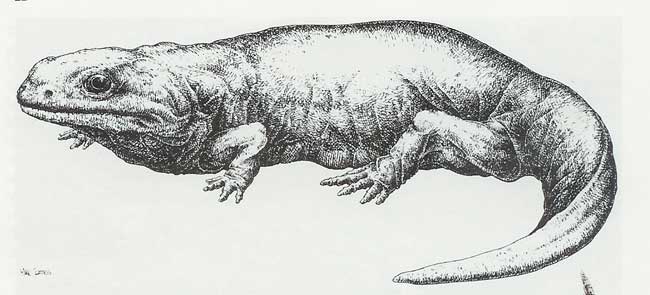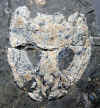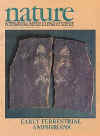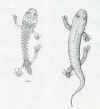|
Next Page
TETRAPODA
Arguably the greatest event in the history of vertebrate evolution was the
emergence from water onto land and the subsequent diversification into amphibian
and reptiles. This transition from fish to tetrapod is poorly represented in the
fossils record and hence poorly understood. Carboniferous amphibians had been
known since the middle of last century but it is only relatively recently that
well preserved Devonian examples were found. In reality the transition from
osteolepidiform to tetrapod was not such a great leap. The former had developed
a bone pattern in their strong fins that would be retained as arms and legs in
the tetrapods, swim bladders would become lungs and the skull structure could
remain unchanged.
Because of the rarity of fossil remains, we have three
successive snapshots of the structure and ecology of the early land vertebrates.
The fossil record starts in the Frasnian/Famennian (374-360myn) with the
Ichthyostegalids from
Greenland
. These early tetrapods were little more the highly modified panderichthyid
fishes. Their skulls were very
similar to the panderichthyids (although lacking the intercranial joint) and
study of the gill arches indicate they spent much of their time in water. They
had a long tail with a fin and limbs with seven or eight digits.
Until the mid 1980ís just a few fragmentary Tournaisian/Visean tetrapod
fossils were known from the Midland Valley of Scotland . More specimens were
discovered in Nova Scotica and
West Virginia
, with a single Namurian Anthracosaur from the Ruhr,
Germany
. All these remains pointed to specialised aquatic forms with few relatives in
the upper Carboniferous. In the 1970/80ís Mr Stanley Wood discovered two
assemblages of early Carboniferous amphibians. At
the Dora open cast coal mine he discovered a bone bed containing six
types of tetrapods including Crassigyrinus (aquatic) and Eoherpeton (tererrestrial).
Ten years later at
East Kirkton
, he discovered a second earlier assemblage from the Brigantian stage of the
Visean, including the earliest well preserved amphibian fossil ever discovered.
What was even more exciting about this site was the complete absence of fish and
presence of terrestrial scorpions and spiders- the first truly terrestrial
amphibians had been found and much earlier than the previous fossil record of
the upper Carboniferous.
The Temnospondyl amphibian Balanerpeton woodei is the commonest form
(around 30 skeletons) at this site.
Such was the importance of this discover it was described in Nature (Vo314) in
1985 and later by Milner AR and Sequeira SEK (Trans of the Royal Soc of Edinb
1994) . The latter publication describes Balanerpeton in great detail including
the following morphological features suggestive of a terrestrial habitat for the
adult:
1) Absence of lateral line sulci, 2) Absence of
ossified branchial system , 3) Possible eyelids, 4)Presence of a large
tympanic ear with rod-like stapes (suggestive of ability to hear high freq
airbourn sound), 5) Ossified carpals and tarsals

Balanerpeton
woodi from THE SEARCH FOR EARLY TETRAPODS, Milner
et al.
East Kirkton
has also yielded a single skull from the earliest known loxommatid and the
remains of the earliest reptiliomorph, Anthracosauroids:
Silvanerpeton miripedes and Eldeceeon rolfei.
Tetrapoda in my collection
(click on thumbnails to see larger images)
Balanerpeton
woodi Temnospondyl Amphibian, Visean,
East Kirkton, Scotland

 Skull Skull
 Lower Jaw
Lower Jaw
 1985 nature article on Balanerpeton
1985 nature article on Balanerpeton   Balanerpeton images from Milner &
Sequeira
Balanerpeton images from Milner &
Sequeira
 Anthracosaur jaw
East
Kirkton, Scotland
Anthracosaur jaw
East
Kirkton, Scotland
 Silvanerpeton skull image from
Clack
Silvanerpeton skull image from
Clack
Other Vertebrates in my collection
(click on thumbnails to see larger images)
 Claudiosaurus, ( basal
diapsid reptile) Upper Permian of Madagascar
Claudiosaurus, ( basal
diapsid reptile) Upper Permian of Madagascar
 Letoverpeton
austriacus Labyrinthodont,
Branchosaurid Bachov,
East Czech
Letoverpeton
austriacus Labyrinthodont,
Branchosaurid Bachov,
East Czech
| 
 1985 nature article on Balanerpeton
1985 nature article on Balanerpeton
 Balanerpeton images from Milner &
Sequeira
Balanerpeton images from Milner &
Sequeira
![]() Anthracosaur jaw
East
Kirkton, Scotland
Anthracosaur jaw
East
Kirkton, Scotland
 Silvanerpeton skull image from
Clack
Silvanerpeton skull image from
Clack
 Claudiosaurus, ( basal
diapsid reptile) Upper Permian of Madagascar
Claudiosaurus, ( basal
diapsid reptile) Upper Permian of Madagascar
![]() Letoverpeton
austriacus Labyrinthodont,
Branchosaurid Bachov,
East Czech
Letoverpeton
austriacus Labyrinthodont,
Branchosaurid Bachov,
East Czech


